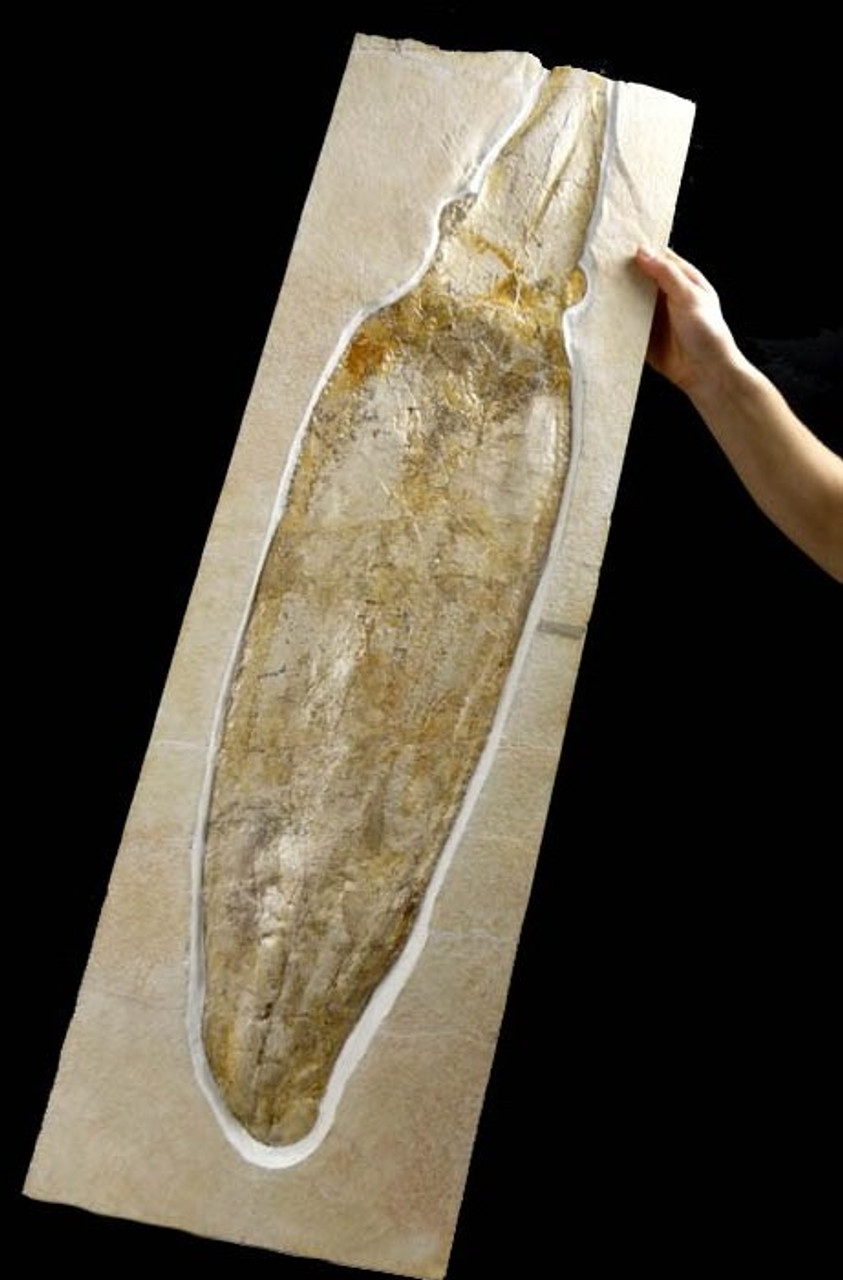Product Description
Over the many years of collecting, preparing and offering a variety of fossil specimens that excel what most museums possess, there are some that will always remain fondly in our memories much like a 'first love'. This specimen most definitely will be one of them! It is an extremely well-preserved and scarce (IN ANY PRESERVATION) Giant Squid (Cuttlefish) from the Jurassic Period. Now extinct, the species name is Leptotheutis gigas. Fossils of this creature are rarely seen even in superb private German collections where these specimens are found. In most cases, diggers only find partial specimens. Major museums in Germany are fortunate to even have one nice displayable one in their collections. This specimen probably rivals most of the few that we have seen. It came from a time many, many decades ago when quarrying work was done by hand and fine quality fossils were possible to find. Today, a discovery like this is a thing of the past, in most cases, as much of the quarry work is done with destructive machinery. Even so, in the best of days, finding a specimen like this would be a once-in-a-lifetime accomplishment for the digger!
If you ever have the rare pleasure of even seeing one of these specimens in a museum, you will appreciate the beauty and unique preservation of this example offered here. This specimen shows FULL PRESERVATION OF ALL SOFT BODY TISSUE, TENTACLE, EYES AND A RARE INFLATED BODY RELIEF. Because squid are mostly soft tissue with only an internal cuttlebone skeleton, rarely are they found preserved as fossils. On this particular specimen, we have anatomical preservation of a type and quality we have yet to see elsewhere. We can attribute such complete and rare preservation to a gentle burial of the original animal and a "top-down view" orientation of the body when covered. This rare positioning allowed for the enormous eyes to be seen flanking each side of the creature.
This specimen comes from a very old (40+ years) German collection back in the day when collectors cared more about finding a place to display their fossils than having large plates for aesthetics. The entire specimen has only been repaired. No part of the squid was restored, only cracks filled from the excavation damage to the plate when the plate was first extracted in pieces. This Giant Squid fossil was pointed with the tentacles out, running out to the edge of the quarry cliff face. This is the reason the last few inches of the tips of the tentacles are missing. This is a natural weathered edge, not missing from digging. These cephalopods had short tentacles so very little is absent. The fact that there is ANY tentacle impression is rare as the majority of these, when they are found, only have the main body preserved, not the tentacles.
In a rough state of decades of handling and poor plate preparation, we re-prepared this specimen in our own lab facility so we can honestly and accurately disclose WITH FIRST-HAND KNOWLEDGE all that was involved in its preparation (Can this be said of most fossil dealers?). As stated, plate has several typical fracture repairs. The creature has no anatomy that has been carved or fabricated. Only the cracks that ran through the body were filled. The entire Giant Squid body is complete and shows something that really makes this specimen good for public exhibit. The body is very inflated - the photos hardly demonstrate this. It is almost lifelike in this full, three dimensional relief. This kind of preservation coupled with the sheer size and mystique surrounding these deep sea predators makes this a fossil perfect for mass public appeal. It really is an impressive piece when seen in person! ALL BODY IMPRESSIONS ARE 100% GENUINE. Ridges running down the center of the body are preserved anatomy of the squid's gladius. The cuttlebone was flattened on its perimeter and left a pearlized impression which can be seen within the larger soft body that would have covered it. The prepared outline of the squid accurately follows the true and complete fossil impression of all rare body parts on both slabs AS IT WAS FOUND. Compare this ultra rare specimen to the others in the world's finest scientific and private collections and we are confident you will have a difficult time in finding a better and more complete squid fossil with such impressions and life-like preservation! If you could care less about scientific rarity, aesthetically speaking, this specimen has no equal, as well. For investment, owning the finest of anything certainly has its rewards. The best fossils offer limitless pride of ownership that can be passed down over multiple generations. Such specimens are amongst the rarest of all collectibles and can also offer promising appreciation in monetary value.
Whether displayed in an advanced private or a large public museum collection, this specimen will undoubtedly be an important and highly regarded example by all that experience it. It certainly would be THE most qualified candidate for textbook or reference book publication. Honestly, A specimen of this rarity and quality deserves a place in a prominent public museum collection for all to enjoy.
Some of the largest dinosaurs that ever walked the earth were in existence when this Leptotheutis gigas swam in the ancient seas alongside massive plesiosaurs and ichthyosaurs!
 US DOLLAR
US DOLLAR
 EURO
EURO
 AUSTRALIAN DOLLAR
AUSTRALIAN DOLLAR
 CANADIAN DOLLAR
CANADIAN DOLLAR
 POUND STERLING
POUND STERLING


















